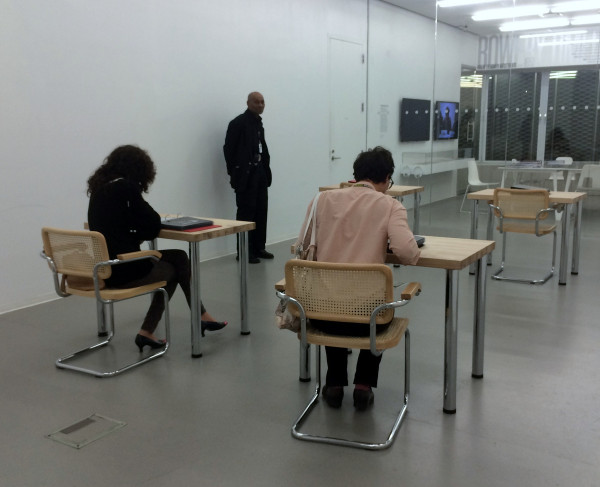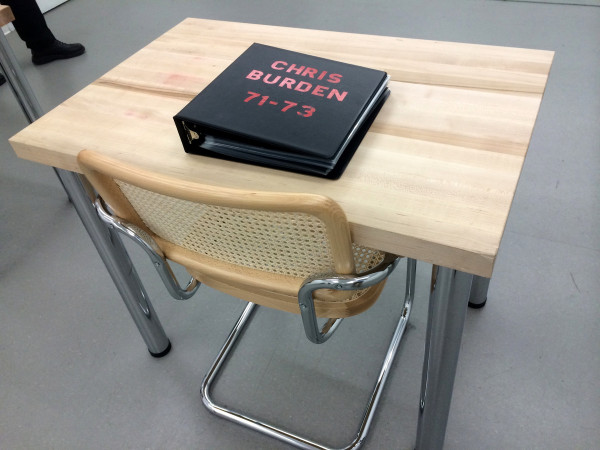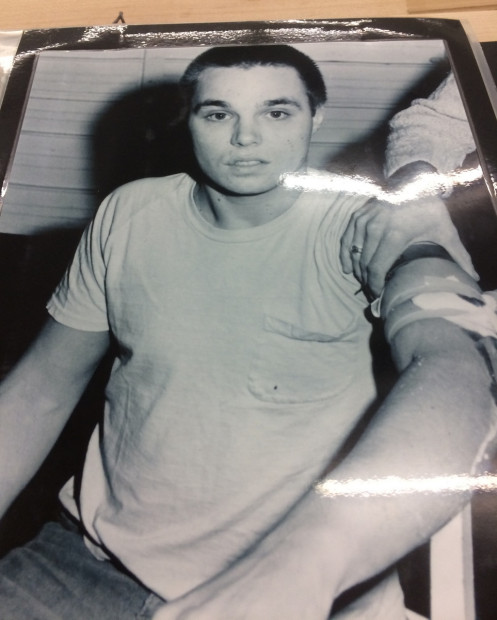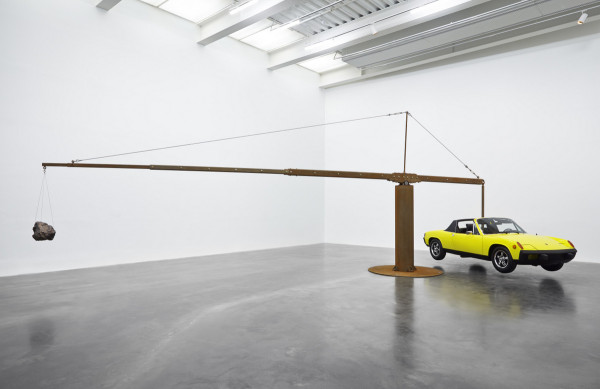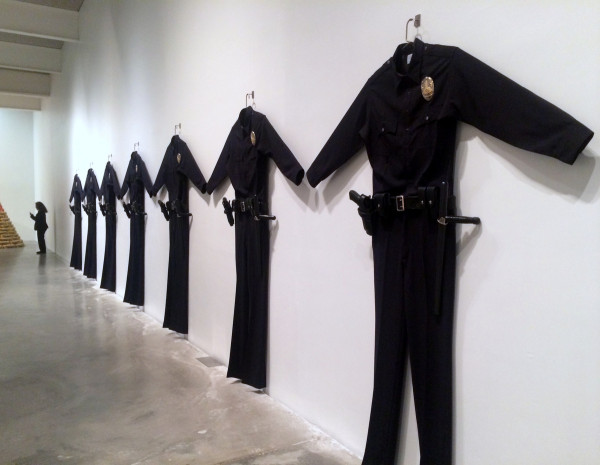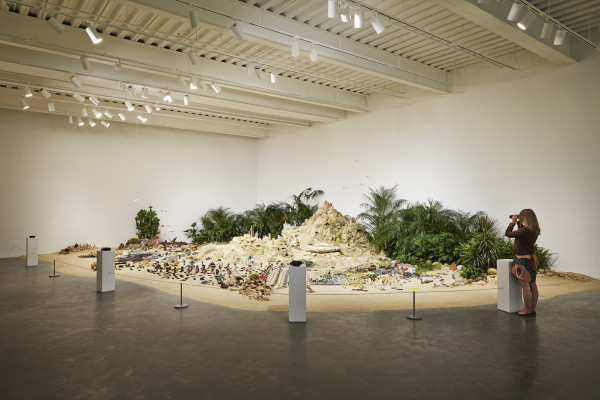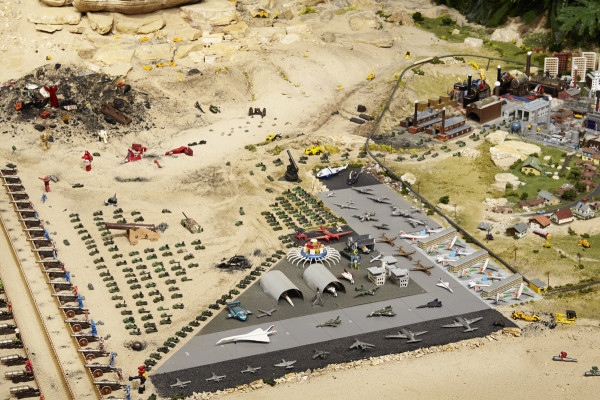During a recent trip to New York, I squeezed as much as I possibly could into just over three days. As usual, the city itself was a visual feast, especially over Halloween. People rode the subway dressed normally but with small flourishes that passed for costumes. I saw a somber woman in street clothes with her face painted white and a disturbing bloody, bullet hole oozing out of her forehead. A “devil” took a break from his work in a bakery and scarfed down a pastry. A man dressed as the Pope nonchalantly skateboarded by me. (I later saw the same Pope majestically float by on his skateboard from my restaurant window.) I wish I had pictures, but these moments were too fleeting to snap. (This NY Times slideshow captures nicely how Halloween weaves its way into the normal, don’t-pay-attention-to-anyone city life.)
Halloween was coincidentally a fitting time to see exhibitions with a slightly creepy, psychological edge from work made by the likes of Chris Burden and Mike Kelley to a group exhibition of 1970s NYC performance artists at the Whitney and even further back to Magritte at MoMA. The following miniseries of posts sum up these shows and more, more, more!
First stop on Halloween night …
NEW MUSEUM / CHRIS BURDEN, EXTREME MEASURES
The exhibition began with an austere reading room to show documentation of Burden’s performance work in authoritative, sparse binders published by Burden. Each binder was marked with the years the performances were done and the pages contained a simple description with corresponding documentary photographs. Next to the reading room were were two small spaces: one with an audio recording playing a BBC interview with Burden done in 2012 about his famous Shoot performance where his friend shot him in the arm with a rifle in 1971, and another small room with grainy videos of his performances that Burden narrated like a DVD commentary.
I appreciated being able to sit down to read the binders in an easily consumable form. I find exhibitions about performance that are basically books displayed on the wall very difficult to get through. It is hard to reconstruct these things in your mind, and it gets really hard when you have been standing on your feet for several hours looking at art. I also loved the decision to let Burden’s descriptions of his performances and sculpture/installations be the primary text throughout the exhibition. His explanations were refreshingly clear, straightforward summations of his actions, minus art speak jargon that either gives something fake gravity or makes it incomprehensible. (You can see the entire exhibition paired with Burden’s statements here.)
Burden’s performances are simple, minimal actions testing his own physical limits. Despite their brute force and matter-of-fact descriptions, they struck me as more soul-searching and personal than I had ever understood. They are an extreme quest to gain knowledge and experience firsthand. He somewhat romantically described a video of Through the Night Softly, a piece where he drags his almost naked body through broken glass on asphalt with his hands bound, as intentionally filmed in black and white because the broken glass looked like “stars” and the colorless video would not show his red blood. He talked about paddling to a remote island in Mexico, trying to test the fantasy of an isolated utopia. It turned out to be a scary hell of simple survival where he spent most of the time under a plywood board trying to shield himself from the sun and get water.

Bernardino Luini, The Penitent St Jerome, 1520-25, Museo Poldi Pezzoli, Milan (left) / Still from Stanley Milgram’s obedience experiments, 1961 (right)
Burden’s testing of his body and purposely putting himself through these “extreme measures” have threads running through them of religious asceticism and self-flagellation (especially Burden’s crucifying himself to a Volkswagen Beetle). Others are like faux psychological experiments that test another person’s willingness to inflict pain on him (in one, a stranger sticks push pins in his stomach). Many of the early performances were done for small audiences or no one. Some involved sealing himself off or disappearing. Burden locked himself in a locker for five days. He disappeared for days at a time completely unannounced without telling anyone.
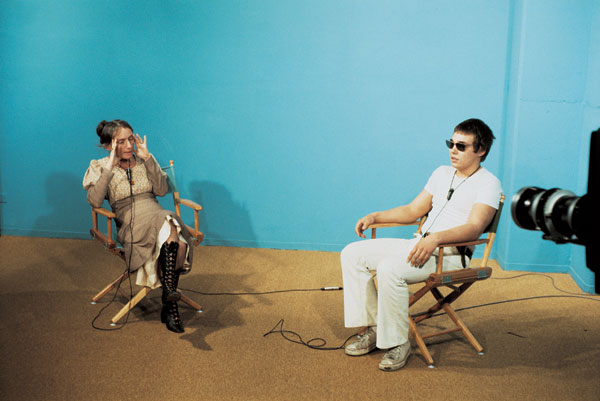
Chris Burden, still from TV Hijack, 1972. Photo: G. Beydler. Courtesy of the artist and Gagosian Gallery, © Chris Burden. (Image not in New Museum exhibition. For more on Burden’s relationship to television, read this.)
Shoot was done in front of 12 people and did not become known popularly until two years later when an image of it appeared in Esquire magazine. Burden became a performance art celebrity, and David Bowie even wound up writing a song about him. Before this fame though, Burden did a project involving television, which included running a snippet of Through the Night Softly as a ten second commercial, so there is no doubt that he wanted some kind of dialogue or relationship with mass media at the time. Burden describes part of his inspiration for Shoot as relating to the Vietnam war and the mediated yet very gruesome images showing people being shot. The gun/violence are also so deeply engrained in American popular culture. He wondered just what might happen to actually do the “real” thing.
The testing of physical limits undeniably has a kind of macho/bad boy aesthetic—like a pre-Jackass era, “yes, I did that”—and the remaining sculpture and installation in the exhibition is like a boy’s fantasy writ large at an almost unconceivable magnitude and precision. Burden, whose father was an engineer, studied physics and architecture, and this shows throughout his work. He builds stainless steel, erector set bridges. He meticulously creates a fake desert/beach where 5,000 war toys engage in mock, miniature battle. He faithfully reproduces a pair of seventeenth-century mortars from the Tower of London that shoot eighteen-inch-diameter cannonballs. He magically balances a 1974 Porsche with a meteor. A six thousand pound steel flywheel silently and effortlessly spins for hours after being set into motion by the loud, muscular roar of a 1979 Denali motorcycle. The small scale gains gravity through accumulation, and the large scale becomes toy-like and weightless.
Burden mixes dark issues of violence/authority with his boyish inquisitiveness and keen sense scale. A row of just slightly enlarged LAPD uniforms hang along one gallery wall with clubs and Berettas. The uniforms take on the look of paper doll cutouts strung together. They look normal when seen from a distance, but at seven feet tall, they swallow you up as you approach them. Are they welcoming the viewer with open arms or linking arms to form a menacing line of power and confrontation? Done after the Los Angeles riots, they have a political edge without being stuck in their time, and installed near work dealing with World War II, they are just another piece in Burden’s idiosyncratic, historical look at issues of authority, conflict, control, and protection.


